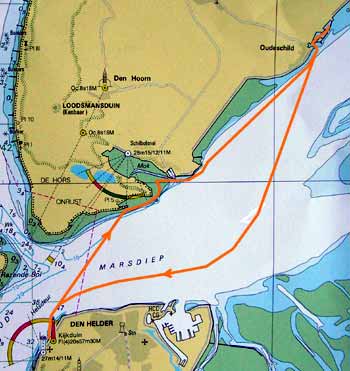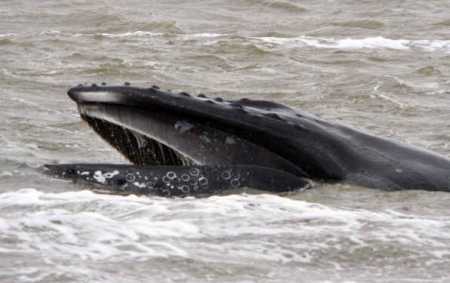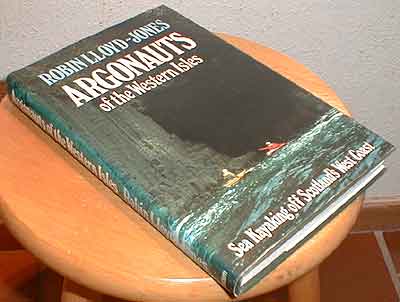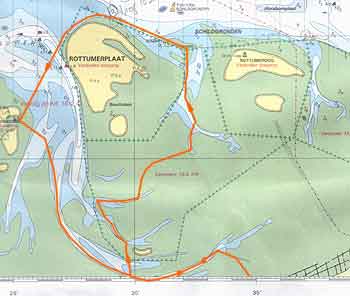- Details
A little rescue-team, consisting of Tiny, Hans, Peter and Axel, pushed and dragged me out of the hole I dropped in.
They assured me it was nonsence to take my site, being more or less a piece of work of a lifetime, out of the air.
Axel even wrote a post in his weblog about it: The art of seakayak reviewing
So there I am up and going again: I needed quite a few hours to repair things. But the site is in the air again.
The future is not yet clear to me, but during the holiday to come, the mountains we are heading for, are a good background for thinking things over.
The problem is wether:
- how to convince a monopolist-retailer, who does not need nor like reviews, that testing seakayaks is a sensible thing.
Or
- how to find other ways to get relevant seakayaks for reviewing.
thx, my little rescue-team
- Details
Seakayaktour 9 juni 2006: Huisduinen - OudeSchild vv.

As it was already 4 weeks ago that I "tasted" salt water, the "sea was calling" me to come again.
4 Clubmembers joined in for a tour to Oudeschild (Texel).
The day before the weather seemed a bit doubtfull as there was heavy rainfall with thunderstorm.
Predictions however said this to be on saterday mainly in the South of Holland. So we took our chance being cautious while looking at the sky and choosing a short crossing over the Marsdiep, paddling mostly along the coast.
- Details
We would have loved it to meet the Humpback whale (NL:bultrugwalvis)(Latin: Megaptera novaeangliae) navigating the Dutch waters these days: A whale which is very seldom seen in Holland.

We didn´t know anything about that it was navigating already there for a few days. But on our way back, from circumnavigating Noorderhaaks, Wieger heard on his radio there was a whale swimming near Huisduinen. So we crossed the Marsdiep in that direction, only to see, when we were halfway, a policeboat and a fast speedboat starting to cross the Marsdiep at full speed back to Texel. Afterwards we heard that the whale has been seen in the Mokbaai; with us crossing at about 2 miles from there without seeing. Grmpfffff....! ![]() Otherwise this already excellent day would have got a golden edge around it.
Otherwise this already excellent day would have got a golden edge around it.
- Details

The ultimate book for tidal heights in Holland is" HP33". This detailed book on tidal heights offers also some information about the tidal streams: Each hour the directions and speed.
This year I discovered that this book is also available in a digital version " NLTides", offering much more possebilities AND information.
The CD introduces itself with this text:
HP33-NLTides provides the official height predictions for all significant porsts from Nieuwpoort in Belgium to lIST in Germany and tidal streams for the Southern North Sea, the Netherlands part of the Waddenzee, Schelde, tidal river area and main port approaches.
Compared with the Paper HP33, NLTides provides more ports, however the predicted tidal heights for the Netherlands ports ans streams information are consistent. The tidal height predictions for Belgium and Germany ports in NLTides are equivalent to the predictions of the UKHO tidal prediction software TotalTide.
HP33D-NLTides is an anual edition providing tidal predictions valif for one calender year. This software is available through the agents of the Royal Netherlands Navy Hudrographic Service (see www.hydro.nl)
What is there more to say after this introduction?
- Details
Yesterday I had my weekly 20km paddle-tour to the kayakclub and back. The weather was very beautiful so I decided it was safe enough, regarding the crossing of the Alkmaardermeer, to paddle my old K1-racer today.
After having started I, developed the target for this evening: "working on my body-posture". Especially the position of my head&neck, as well as keeping my upper body straight while paddling.
This is related to my visits last months to a Mensendieck-therapist because of neck-problems. It turned out to be that pushing the head forward (something I clearly did so for years already) puts an enormous strain on the neck.
By reducing that, with help of Mensendieck and exercises, I managed to solve cq. reduce the problem in daily life. However while kayaking this turns out to be more difficult as it is not so easy to ban out the habits of a lifetime of paddling. As I noticed last years that I had a very tired neck after a heavy paddling day, sometimes even resulting in severe headaches ![]() , it is necessary to improve my paddling style as well. I am proceeding gradually however and evenings like this help a lot.
, it is necessary to improve my paddling style as well. I am proceeding gradually however and evenings like this help a lot.
It feels a quite bit contradictionary, while pushing and pulling your paddle, to straighten your backbone, to push forward your breastbone and, as a result, hold your head higher.
I got the impression tonight that working on my posture also results in higher speed. But after realising sometimes ""Hé men, you´re cruising at 10km/h now![]() often the "FLOW" was gone immediately with a dropping speed as a result.
often the "FLOW" was gone immediately with a dropping speed as a result.
However focussing on posture helped quit a lot in getting "flow" again.
This is what I concluded:
- Details
Being virtually attacked, I worked hard last weeks to move the whole blog and all the posts to another system.
Apart from a better functionality, my aim was also a better protection of the blog.
I hope the blog does what you expect from it.
It if does not function well, please let me know.
Fortunately![]() it was possible to maintain the current weblog-address. However it was not possible
it was possible to maintain the current weblog-address. However it was not possible ![]() to have the same RSS-feed.
to have the same RSS-feed.
So if you follow my blog with a feedreader, please find the new RSS-feed at the bottom of this page.
- Details
Click on the map for an enlarged version
At 9.00h it was high tide, but leaving then would mean that we had to leave even earlier from home. And today I had to wake up at 5.00h already, for we planned to start at 10.00h.
We were with a nice group of experienced paddlers (Rob, Wieger, Wietse, Henk, Annet, Jos, Maarten and myself; all members of KVU) and the weather was perfect for this tour: the sky was blue and the wind only NE3Bft. The only thing is that you are not yet used to this kind of summer-conditions in april......................................>>
- Details
This is the title of a book from earlier days (before1989) in seakayaking and is describing seakayak explorations along the Scottish coast.
Days in which nobody could think of a GPS, a GSM, a satelite telephone or other modern gear. But the kayakkers of these days turned out to be very skilled in navigating without al this.

As I read the book long ago, it comes sometimes back into my mind togeter with the wist to read it again. So I tried to buy it, but I did not succeed. Even a secondhand one stayed out of reach.
BUT: as a suprise a good friend of mine, Hans Ammerlaan and a collector of ancient kayaks books, phoned me on the 1th of april:
""are you still interested in The Argonauts... ? Yes of course!! You found one for me? OK, just buy it!""
After some hours, I must confess, I thougth " could this be an 1-april-joke ?" No...., I never saw Hans think of jokes like that.
So, Yesterday there it was, Hans dropped by and brougth me the book. Unfortunately I was not at home and he had it carefully dropped in the postbox by lowering it with a rope.
THX Hans!!!
So now the reading can start. What I especially remember from the book is an impressive tour where a couple of the leading seakayakers from the time dit meet themselves after having decided they could manage to paddle home after a gale did come up.
They felt immense small and lonely in this see and did learn they should ever respect the sea.
- Details
Last wednesday-evening I was paddling a Baidarka with a kinetik wing-paddle for a tour from home to the kayakclub and back; in total approx. 20km.
For this occasion I took my GPS with me for recording speed. At first I adopted as a target to paddle at 8-8,5km/h, because it felt quit relaxed this evening and as an experiment how I could maintain this.
At a certain moment my GSM came to life: ring-ring: Jos here!; Where are you?
Jos was paddling in the northern part of the "Alkmaarder meer" and we made an appointment to meet somewhere in the middle. From that moment on I let go my speed-target and decided to go for the highest speed possible for the distance. At first this was something between 9-9,5km/h. After a while however, when coming in some kind of a cadence, I noticed I went down to 8-8,5km/h, although it felt as if I was working harder than before. Strange!
As I heard my paddel blades bubbling cq. cavitating while pulling through, I tried to concentrate on tecqnique and forget about speed. This worked: as the cavitation noise disappeard, my strokes were longer again and with the correct body-rotation, I reached the 9,5km/h easily again.
5 minutes later: I spotted 2 clubmembers ahead of me and automaticaly I started thinking of overtake them.
And again the speed dropped an again I succeeded, after realizing this, to concentrate again and to speed up.
Later in the evening I was paddling home again. As it was later than planned, I was very eager to arrive at home and tried to go for the highest speed I could reach.
But again I was was only cruising at 8-8,5km/h. This time however I could not forget my desire to go fast AND thus my speed did not become higher.
Partialy this could be due to getting tired, but as paddling felt different now, not as fluently as before, I concluded that the maximum speed you can reach, is partially also a mental issue.
When you are too eager to go fast, you can't.
May be the message should be: relax your mind and just go!
So there is still something to learn![]()
- Details
While Willem Molengraaff and I had been testing quite a lot of seakayaks during the last 15 or 20 years, we only noticed that there are not very much testreports on seakayaks available on the internet.
Of course we know the reports in The Seakayaker Magazine. They seem to work with a standard group of testers and they make a structured summary of the remarks they recieve from the testers on the kayak.
But besides that we did not find any structured tests of seakayaks in the world.
Of course there is paddling.net where everybody can posts his or hers comments on a kajak in the review-section. This is of course very interesting, but you not always get a complete impression of the kayak.
Than there is the Norwegian magazine "Paddling" where, since 1 or 2 years, testreports are now published. The point is: you must be able to read Norwegian and these tests are not available in the "world wide web".
As I can read norsk I am thinking of subscribe to this magazine. Only have to investigate how to pay without to much administrative costs for crossing the money over the Dutch border.
But now something has changed as I noticed that there is Douglas Wilcox testing seakayaks as well and publishing reports on his weblog
SeaKayakPhoto.com.
I am happy to mention 3 tests from this collegue in testing:
Rockpool - Alaw and Alaw Bach
P&H -Quest LV
Valley - Nordkapp LV

